The Association of the Unknown Shore
How might Bristol productively acknowledge its ongoing colonial legacy and contribute to the work of truth and reconciliation with Canada’s First Nations, Inuit and Metis people? What is the potential role of arts practice within this process? How might contemporary enactments, ceremonies, and rituals devised in response to the archival and material records of this history make visible Bristol’s role in north American colonisation?
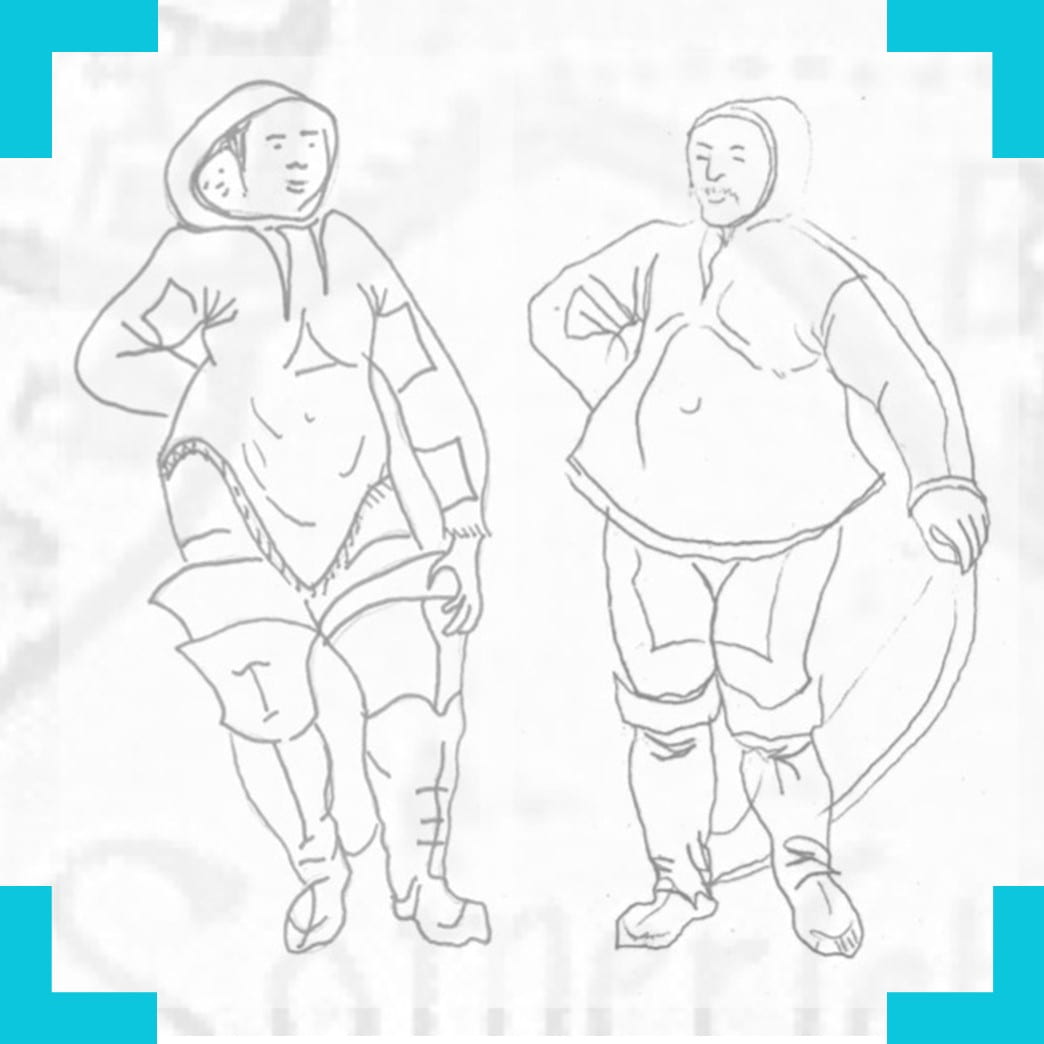
The project sought to acknowledge the entangled networks of Inuit and British material cultures in the city of Bristol. To do this the team addressed the legacy of Martin Frobisher’s attempt to ‘discover’ the Northwest Passage. Frobisher’s three voyages (1576-78) instead encountered Nunavut, in what would later be named ‘Canada’. These voyages enacted complex events, including the disappearance of four sailors; the capture and hostage-taking of four Inuit people who were brought to UK as proof of a strange and ‘savage’ land; a resource-extracting venture which turned into the first major gold-mining fraud in European history and involved the embedding of Nunavut ore in the British built environment; and a bungled attempt to establish a British colony – including the building of a small ‘English’ house at the summit of the Countess of Warwick’s Island (now known as Kodlunarn Island) – which became the first step in the eventual establishment of British sovereignty over this northern half of the American continents. Three people from Nunavut – Arnaq, Callicho, and Nutaaq – were brought to Bristol and died here, their deaths registered at St Stephen’s Church. Before he died, Callicho performed an Inuit hunting display on the Avon. English oak, English stone, brass anvils and bells were left on Baffin Island and have become part of contemporary Inuit culture. Two thousand tons of Nunavut Amphibolite were incorporated into the fabric of buildings in Britain. The traces of Callicho’s hunting displays – the kayak and spears – are lost, but assumed to remain in England. Songs were exchanged between Inuit people and sailors. These voyages mixed peoples, ideas, objects and practices and they link the material pasts, presents and futures of the people of Bristol and Nunavut.
What did the project involve?
The Association of the Unknown Shore is an interdisciplinary partnership that centres on co-produced practice-as-research. It is a network of artists, academics, curators, and the Church of England. The Association built a wider network to include Inuit artists and cultural organisations, contemporary art curators, and local artists to focus on collaborative, wayfinding goals and on questions of audience and spectatorship.
The project involved developing methods, modes and ethics of working together. They sought to build the Association of the Unknown Shore in order to investigate how art and academic practice can contribute to an active politics of place.
The project was based on the following research questions:
- How might Bristol productively acknowledge its ongoing colonial legacy and contribute to the work of truth and reconciliation with Canada’s First Nations, Inuit and Metis people?
- What is the potential role of arts practice within this process? How might contemporary enactments, ceremonies, and rituals devised in response to the archival and material records of this history make visible Bristol’s role in north American colonisation?
- What are the mutually transformative exchanges that might occur between and across participatory art; the research practices of historians and geographers; the social mission of the Church of England; museum practice; and the work of Inuit cultural organisations?
- How might a conversation between the 16th-century technologies of exploration and representation and the contemporary technologies used in this project be used to ‘indigenise’ Bristol’s history and contemporary urban landscape?
- How might the Association bring a distributed, participatory artwork to a diverse audience, local and international?
The project sought to produce a collections of works that focus on approaches to Frobisher’s multi-scalar and multi-vocal legacy. The production of these works began with three days of meetings and fieldtrips to discover, map, and engage with important historical sites.
During this project, the assocication came together to work on and create the following:
- A document that brings together material and archival traces to visualise relationships between land and social fabric in UK and Nunavut.
- An imaginary museum display to enable investigation of scale, objects and senses of exhibition.
- A performance work-in-progress about the role ceremony and ritual played for both English and Inuit cultures of the late 16th century. Specifically, they worked with the English naming rituals performed through Frobisher’s voyages, sailors’ songs and the song that Callicho sang on leaving his homeland and again on his death bed.
- A script to explore the productive role of text as a creative medium and prelude to event. How might the script operate as a set of rules, protocols, prefigurative politics, utopian proposition for other ways of being?
- Drawing on the ceremonial performance and script, the team sought to develop a public event-in-progress that enacts the Avon Duck Hun.
Who are the team and what do they bring?
- Angela Piccini (Film and Television, University of Bristol) has 15 years’ experience of co-produced and practice-as-research. She is interested in the creative uses of the past in the present and has a track record of research that connects archaeology & heritage with media practice.
- Kayle Brandon works in public and social contexts and her interdisciplinary practice responds to place, politics, ecology and anthropology. Beginning in 2011 to work with Bristol’s Inuit history, she undertook a residency at Acearts (Winnipeg, Canada) in 2012 and connected with Robert McGee (Meta Incognita project; The Arctic Voyages of Martin Frobisher, 2002). In 2012, Brandon conducted
participatory drawing events and gave talks at St Stephens Church, focusing on the Inuit story. - Lee Barnes (St Stephen’s Church) is the Reverend priest at St Stephen’s church. The church was once the harbourside church. It is embedded in Bristol’s port history and is an active member in truth and reconciliation processes. For example, in 2011 artist Graeme Mortimer Evelyn created ‘Bristol Reconciliation Reredos’ a permanent artwork for the church that addresses the ongoing legacies of the transatlantic slave trade.
- Sue Giles and Lisa Graves (Bristol Museum) are curators of World Cultures at Bristol City Museum. They work in partnership with First Nations and Native American artists and communities, including funded projects exploring Native American visitors to Britain and British public and political engagements with Native Americans and conservation work with the Cree Cultural Institute that will send back on loan two painted hide hunting coats and a beaded hood.
- Richard Stone (History, University of Bristol) is a historian whose specialism is Bristol’s seventeenth century overseas trade. Specific research areas include international trade, the growth of the English colonies in the Americas, and Piracy.
- Evan Jones (History, University of Bristol) is a historian of economic and social history. He specialises in late medieval to early modern maritime history, particularly in relation to Bristol. He runs the Cabot Project, which focuses on Bristol’s fifteenth-sixteenth century voyages of discovery.
- Mark Jackson (Geographical Studies, University of Bristol) is a researcher of postcolonial geographies. He focuses on how the postcolonial imagination and decolonising intellectual projects are being shaped by posthumanism. His broad aim is to rethink the political and ethical meaning of critique within relational ecologies.
What were the results?
On 20 October 2018, at Arnolfini, from 10am-4.30pm, the Association of the Unknown Shore met to acknowledge the ongoing legacy of the presence, in the autumn of 1577, of Kalicho, Arnaq and Nutaaq in Bristol. They state:
“Their story is how we continue to breathe coloniality. Cartography, navigation, bad faith, magic, alchemy, comets, land theft, shareholders, gold fraud – all still shape lives now.
Our aim has been to unsettle – ourselves and others. What would it be to ask whether the city of Bristol is also an Inuit city? What would it be to ask whether Inuit communities also have claims to this city’s land and resources? What would it be to ask whether artistic responses to this history and its contemporary legacies can aid in the unsettling?
For this Open Meeting, works included Mark Igloliorte’s Study for Traditional Seal Skin Neck Pillow (2018) and mixed media work-in-progress of the Association of the Unknown Shore. Activities include talks, walks, narwhal tusk casting, underwater recording. We also screened Alethea Arnaquq-Baril’s film Angry Inuk (2016, NFB).”
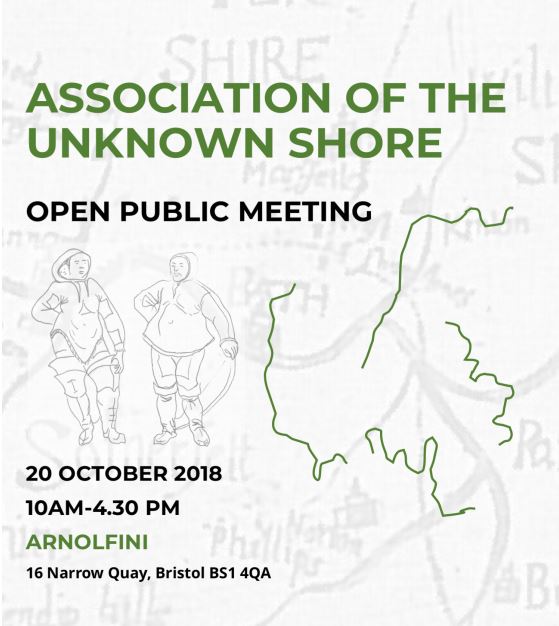
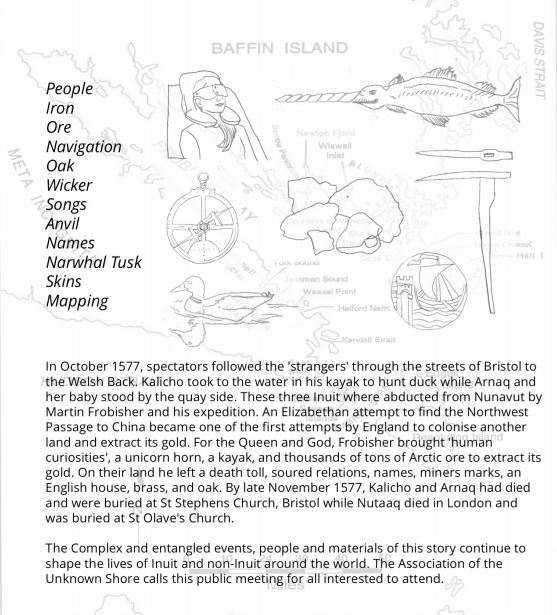
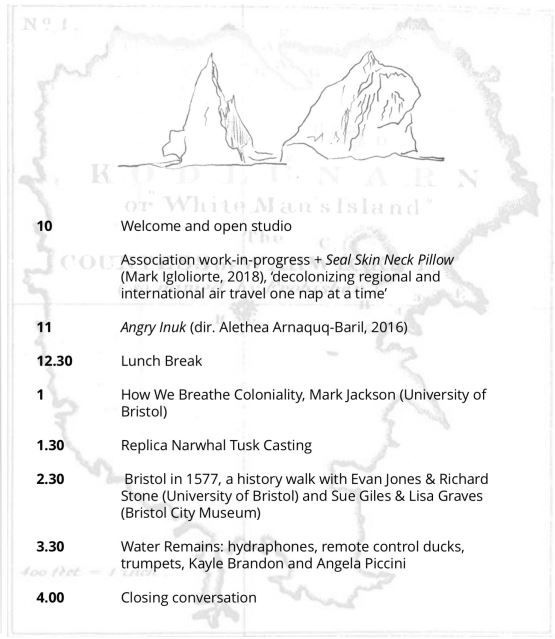
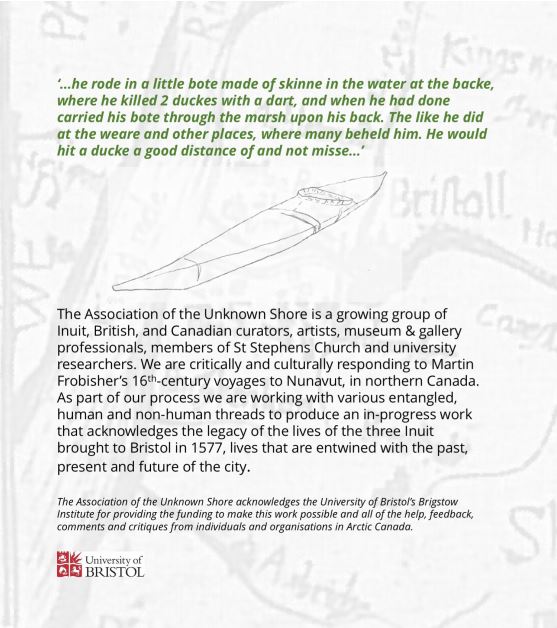
The project team were able to secure funding from the Arts Council England to take the Associations of the Unknown Shore work further.
Please visit the Associations of the Unknown Shore Website.

